
Published: September, 1964
Script: Stan Lee
Art: Steve Ditko
Letters: Sam Rosen
And now we present: Amazing Spider-Man Annual #1! It’s 72 pages long, and cost 25 cents back in 1964, but those kids sure got their money’s worth with this one. The feature story alone is 41 pages, and so characteristically wordy, that by the time I finished, I didn’t have the strength to go on with the rest of the book. So it took me a couple of days to get through this. Whew! Here are a few observations.
THE SINISTER SIX
Spidey fights six of his most famous villains in this one. Six! Count ‘em! Six! Electro, Kraven, Mysterio, Sandman, Vulture and Doctor Octopus.
However, because each villain so egotistically believes that HE will now be able to defeat Spider-Man on his own (even though he hasn’t been able to do it in the past), the battles take place sequentially, rather than all at once. Once it’s all over, even Spider-Man admits that if they hadn’t each been so eager to get the glory, and had teamed up against him, they might have won. Woulda, coulda, shoulda. Too late now. The six are toast, and we may have to wait until the next Annual to see if, once they all get out of prison, they’ll have any better luck tackling the Amazing Spider-Man.
I’M READY FOR MY CLOSE-UP, MR. DITKO!
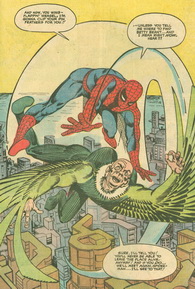 Russ tells me this Annual is famous for two things. One: six full page pics of Spidey dealing with each of his opponents in turn. It’s easy to say which one is my least favorite. It would have to be Spidey’s portrait with the Vulture. First of all, the Vulture continues to underwhelm me as a villain, and in this shot, Spidey is clearly in control of the action.
Russ tells me this Annual is famous for two things. One: six full page pics of Spidey dealing with each of his opponents in turn. It’s easy to say which one is my least favorite. It would have to be Spidey’s portrait with the Vulture. First of all, the Vulture continues to underwhelm me as a villain, and in this shot, Spidey is clearly in control of the action.
However, picking a favorite is not so easy. For me, it’s a toss-up between Mysterio and Electro.
There’s so much going on in both these pin-ups. I love the colors in Mysterio’s portrait, and the breaking glass. Best of all, you get that odd sensation that Mysterio’s cape clasps are his eyes. Russ has told me that as a kid he was convinced the ornamentations on Mysterio’s costume were actually his misplaced eyeballs, and you can really see that here. It’s weird and eerie.
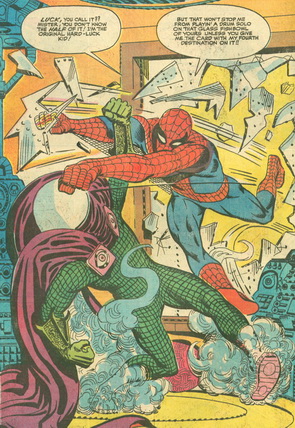 |
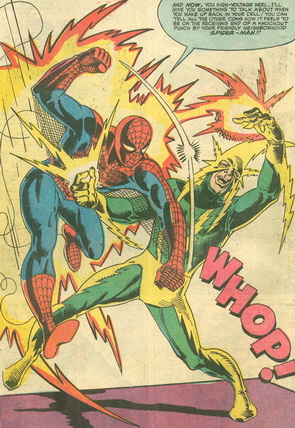 |
As for Electro, can’t you just feel the power of the electricity in all those jagged yellow and orange points? And Electro himself looks totally beaten (or should I say “whopped“?) as Spidey lands a full swing punch to his spiky mask. In both pictures, only one of four feet are on the ground, giving a sense of action, motion, excitement. It’s great storytelling in a single panel.
For comparison’s sake, here are the other three full page portraits:
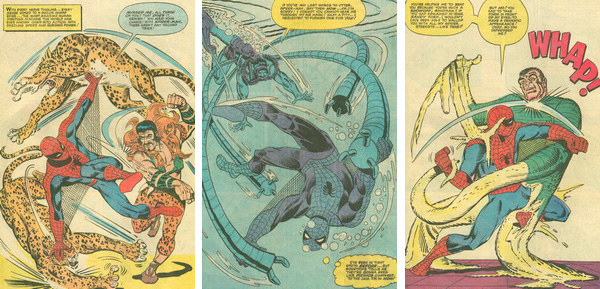
If anyone wants to make a case for any of these being the best, please do! I’d love to hear which of these most appeal to other Marvel fans.
BE OUR GUEST! BE OUR GUEST!
The other thing that gives this first Spider-Man Annual its place in comics history is the wide variety of guest stars. Almost every Marvel superhero of the day shows up, and for most, it’s more than a cameo appearance—there are plenty of speaking parts! Torch and Spidey go through their standard teenage rivals routine for more than a full page, and Captain America and Reed Richards confer via video chat when Spider-Man goes missing.
CLUELESS
It’s always fun when characters pop into each other’s stories, but for amusement, nothing beats Aunt May’s completely clueless commentary when she and Betty Brant are kidnapped by Dr. Octopus.
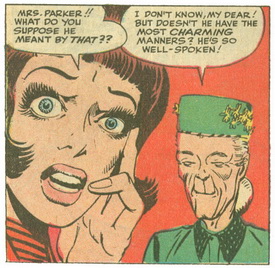 Betty clearly understands that it’s not acceptable to be held against your will, even if your host is serving coffee and Danish pastries, but Aunt May keeps acting like she’s at a tea party. Until Spider-Man shows up to rescue them. Then she makes note of the stark contrast between their well-spoken, most charming host, and the “villainous-looking” Spider-Man in his “perfectly ghastly outfit,” who doesn’t even knock when he enters the room. I DO declare!
Betty clearly understands that it’s not acceptable to be held against your will, even if your host is serving coffee and Danish pastries, but Aunt May keeps acting like she’s at a tea party. Until Spider-Man shows up to rescue them. Then she makes note of the stark contrast between their well-spoken, most charming host, and the “villainous-looking” Spider-Man in his “perfectly ghastly outfit,” who doesn’t even knock when he enters the room. I DO declare!
In the end, poor Aunt May has to admit, “I’m afraid I don’t understand ANY of this!” That’s okay, Aunt May. What you don’t know can hurt you…but not if you live in the same universe with your friendly neighborhood Spider-Man!
THE SECRETS OF SPIDER-MAN
After this lengthy entertainment, we move on to “The Secrets of Spider-Man,” a feature which might as well be called “The Science of Spider-Man.” Basically, it’s a re-hashing of all of Spider-Man’s fantastic abilities, most of which we already know inside and out, but I did pick up a few more interesting tidbits.
For instance, did you know…?
- Spider-Man is probably the world’s greatest authority on the subject of webs and their creation
- He can life 40 times his own weight
- He can jump three stories with a single spring
- He is easily the greatest balancer of any human being on earth
- His webbing disappears into nothingness after one hour
- Only Daredevil has more highly developed senses
I especially like the bit about the webbing disappearing after one hour. It never occurred to me to ask what happens to all that nasty webbing lying around after a fight. Sort of like Buffy’s vampires going “Poof!” in a cloud of smoke, no body or bones to clean up, that webbing trick is awfully convenient. Leave it to scientific high school genius Peter Parker to figure out a way to make a substance that’s so strong it can support the weight of a full grown man to ALSO have the handy-dandy property of delayed disintegration.
This short feature is also a great way to “toot the horn” for the artist. “Marvel’s merry madmen are exceptionally proud of Steve Ditko’s superb portrayal of Spider-Man in action,” but I am exceptionally proud of Marvel’s merry madmen for this:

We always known the artwork works, but now we know why it works. Any questions? I didn’t think so. Let’s move on!
A GALLERY OF SPIDER-MAN’S MOST FAMOUS FOES
Next we take a quick peek at Spider-Man’s villains, and sadly, this gallery of ne’er-do-wells is nowhere near as impressive as it could be. It’s an odd conglomeration of the powerful and the pedestrian.
The Burglar? Yes, he shot Uncle Ben, but other than that, has little to recommend him as a villain. Nice detail in his pin-up, though, with a couple of rats and broken bottles.
Next, it’s the Chameleon, the Vulture, the Terrible Tinkerer. We seem to be descending rapidly into the pit of “ho-hum” villains, but pick up again rapidly with Dr. Octopus, Sandman and Doctor Doom. We don’t usually think of Doom as a Spider-Man villain, though they did butt heads briefly in ASM 5. Doom’s inclusion on this list seems to be a marketing ploy for the Fantastic Four Annual, also hitting newsstands this month.
The Lizard, the Living Brain, the Enforcers. See what I mean? But also: Electro, Mysterio, Green Goblin and Kraven. My main impression, coming to the end of this feature, is that Spider-Man villains are like a box of chocolates—you never know what you’re gonna get.
A LITTLE BIT OF THIS, A LITTLE BIT OF THAT
And I guess in an Annual, you never know what you’re going to get, because after all these villains, we see “Peter Parker’s Favorite Heel and Heart-Throb,” highlighting Peter’s work colleagues J. Jonah Jameson and Betty Brant.
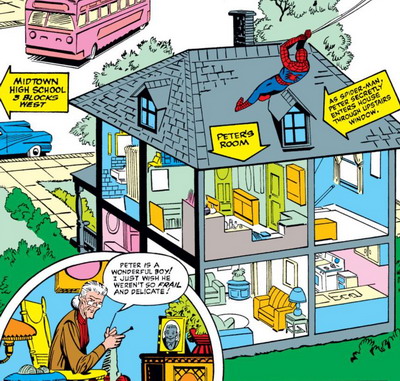 It’s only one page, then on we go to “Peter Parker’s Classmates,” which pokes fun at Flash Thompson and suggests “there are more great athletes who ARE good students, than aren’t!” (Surprisingly, no editor’s note directs us to the latest edition of Daredevil, the Man Without Fear!)
It’s only one page, then on we go to “Peter Parker’s Classmates,” which pokes fun at Flash Thompson and suggests “there are more great athletes who ARE good students, than aren’t!” (Surprisingly, no editor’s note directs us to the latest edition of Daredevil, the Man Without Fear!)
A Guest Star Page finishes up this hodgepodge of single page features, but not before we’re treated to a detailed map of Peter Parker’s house. I always love a good map, and this one reveals how Spider-Man secretly gets in and out through an attic window. Aunt May, seen here in her rocking chair, knitting, is clueless, as usual.
HOW STAN AND STEVE CREATED SPIDER-MAN!
Finally we have this tongue-in-cheek compilation of the foibles that go into creating a comic book. On one level, it’s a string of jokes, but it does make you wonder how much of the aggravation expressed in these word balloons was perhaps a little too close for comfort. Best line, by “Ditko”: If all the web-lines I’ve drawn were laid end to end, they STILL wouldn’t be enough to fit around Lee’s swelled head!!
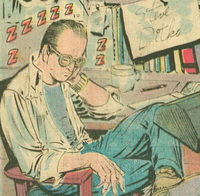 In the end, the first issue is completed, and with a sigh of relief, Ditko plans to sleep for a week. Not so fast, my friend! You know there’s a half-dozen or so new comic mags in your “To Do” box. If this little feature accomplishes anything, other than giving readers a few good laughs, surely it reveals the breakneck pace at which this work was done. I come away with a new appreciation for the Marvel Bullpen’s grace under pressure.
In the end, the first issue is completed, and with a sigh of relief, Ditko plans to sleep for a week. Not so fast, my friend! You know there’s a half-dozen or so new comic mags in your “To Do” box. If this little feature accomplishes anything, other than giving readers a few good laughs, surely it reveals the breakneck pace at which this work was done. I come away with a new appreciation for the Marvel Bullpen’s grace under pressure.
| Want to read this comic on your computer? Marvel has a scan! Want to own this story? Buy the Masterworks! |















Hi Chrissy,
I greatly enjoyed your take on one of my favorite comics. I presented my thoughts on ASM Annual on my blog a little over a year ago, for those interested: http://nick-caputo.blogspot.com/2014/07/50-summers-ago-amazing-spider-man.html
This issue was a real treat for many reasons, particularly for the effort Lee and Ditko brought to make it a real special, including all those full page illustrations. I’d agree with you on Electro and Mysterio being the top two; I’d have the Sandman a close third.
One issue I had with the story was that Aunt May was characterized as too ditzy and clueless. In the monthly comic she was always overly concerned for Peter, but also came off as a strong, determined woman (see # 18). Her disliking Spider-Man was not very different from many others who read the news reports (and the Bugle) that categorized Spidey as a criminal.
The Gallery of Villains was presented in strict chronological order of appearance (from Amazing Fantasy # 15 up to the latest issue of the monthly comic Lee and Ditko had completed when they produced the Annual, ASM # 15. They included every new villain up to Kraven.
One correction, Amazing Spider-Man Annual # 1 was published in June, not September. The GCD incorrectly listed it as September, but in their notes section they have the correct date of June. In the 1960s almost all Marvel’s Annuals were on the stands in June-August, the peak selling period when kids were off from school in the summer.
It’s always bothered me that the magazines at the checkout counter claim dates so far in the future. You may not know this, but Ladies’ Home Journal is just like the comics. The way Russ explained it to me, the dates are there to tell the magazine distributor when to pull the item off the shelf. So, if a book comes out in June, but it says “September,” it remains on the newsstand and available for sale all summer long. Ingenious! For the purposes of this blog, we’re just going with whatever month is mentioned on the cover.
And BTW, I’ve just read ASM 18, and this Aunt May is indeed strong and determined, not ditzy at all! So much so, I’m not sure she rings true. I’m feeling like the real Aunt May probably ends up somewhere between these two extremes.
Not just this annual, but all the books that we’ve featured as “Published: September, 1964,” and an upcoming “Meanwhile: September, 1964” post, were actually physically printed in June, not September.
As Chrissy hints, this was a choice that we had to make when we started the blog. We just felt that, if we were to say: “Published: June, 1964”, which is literally true, we’d get even more questions that said, “How can you say it was published in June? It says right there in the indicia: September!”
By the way, rather than comics.org, we use Mike’s Amazing World Newsstand page to help us organize which books belong in which month. Is there a quick way in comics.org to tell us which books were “published” in a given month?
Hi Russ,
I completely understand the cover date dilemma and agree that your solution makes the best sense. However, Annuals (at least the ones you’ve written about thus far) feature no cover dates either on the cover OR the indicia, so I’d avoid any date and list it as Spring or Summer 1964 since all the annuals appeared in either of those two seasons. Mike’s Amazing World is a incredible resource and I use it often.
Re: the GCD, the on-sale date is included when the information is known. It appears in the indicia section above the cover (beginning with Price, Pages, Indicia Frequence and on sale date). ASM Annual # 1 includes the on sale date: June 11 1964. http://www.comics.org/issue/18069/
I just checked and cover dates on Annuals appear on covers beginning in 1966 (although Annuals are then called “King-Size Specials” just to confuse Chrissy more!)